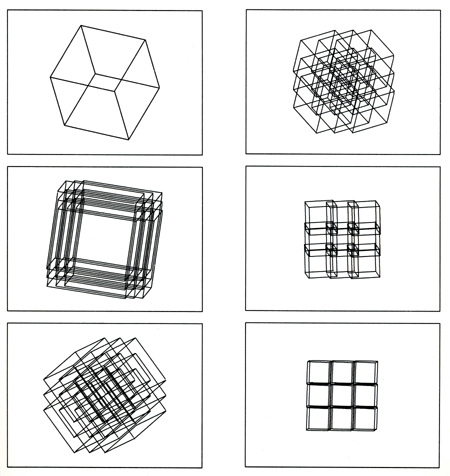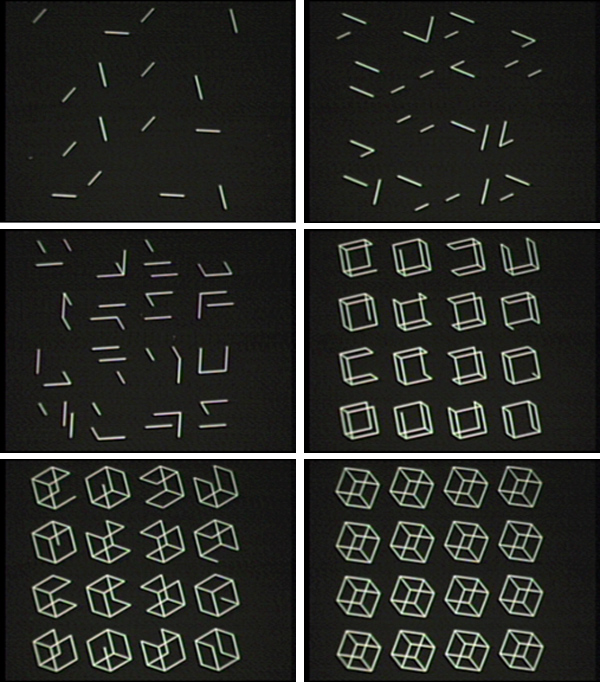Manfred Mohr
Monday, 8 April 2013
Work from his oeuvre.
“…The inevitable question that arises in response to algorithmic based art is the aesthetic value of something where the work is supposedly done primarily by a computer. The artist to some is perceived as absent from such mathematical constraints and rules of logic. It’s as if to give way to an automated system is to deny the potential of artistic expression insofar that these restrictions by their nature can only have specific, predetermined outcomes. Systematizing the process of art-making inhibits expressivity, but as formalistic as algorithms probably are on a superficial level, they are manipulable and can lead to wildly expressive potentialities.
Art that manipulates algorithms within a specific set of parameters to achieve unexpected results, or generative art as it is generally known, has risen to prominence within the past twenty years. Its popularity as an art form has perhaps grown in the last decade as our relationships to the world become increasingly mediated by digital technology and as the algorithms at the heart of those technologies become more omnipresent. Despite this recent popularity, the notion of using algorithms to create art reaches as far back as the 1960s when artists would use plotters (or automated drawing machines) to generate art from written programs processed through the devices.
Considered to be one of the fathers of digital art, Manfred Mohr was one of the first to use these generative methods digitally to make the majority of his works. Born in 1938 in Pforzheim, Germany, the New York based pioneering artist was originally a jazz musician and painter whose sensibilities leaned more towards the work of the abstract expressionists and action painters, in particular the works of K.R.H Sonderberg. However, he was then introduced to the work of German philosopher Max Bense whose Aesthetics of Mathematics sent him in the completely opposite direction. It became clear to the artist that to fully realize and communicate his intentions he would have to divest himself of the obscuring emotional nature of action painting and pursue more rationalistic constructions of geometric forms. If traditional art meant to stimulate the heart, his was meant to stimulate the mind.
Mohr’s interest in a systematic generation of geometric forms predates even his use of computers. His work phase hard edge saw him introduce geometric shapes that would operate as visually expressive signs when juxtaposed with each other. Very early in his work he restricted himself to the colors black and white, a restriction that would last almost 40 years. The binary provided more freedom to focus on the spatial relationships of lines, points and shapes that would comprise the majority of his art. The breakthrough to actually use computers came when he met Pierre Bardaud, a musician composing music with computers. Subsequently, he was inspired by the meteorologists’ use of plotters and sought to use one for his work. Soon after he began programming his own algorithms in the FORTRAN programming language as soon as 1969.
However, Mohr’s investigations into rational forms generated digitally should not be considered a relinquishing of control on the part of the artist. Instead, his pursuits are better thought of as an extension or enhancement of the artist’s abilities. Mohr’s use of the algorithm to create art can be understood as an appropriation of a mathematical form to investigate aesthetic possibilities that are out reach of immediate human comprehension. Mohr put it the best when he characterized his own work as “inconceivable, but yet computable.” The algorithms that the artist used were developed by Mohr himself and much of his process involved a continuous engagement with their interpretation by the machine. He would continually produce results and tweak his programs until he was satisfied with what was created. Mohr took advantage of a computer’s precision. It has the ability to rigorously reproduce and to also produce infinite familial variations within the context of those reproductions without degradation to that goal.
In particular, the series of forms that comprise the majority of his work are to be seen as collections of signs. Contrary to their procedural origin the signs as they exist within context of a particular work are intended to individually communicate aesthetic information against an objectified backdrop. He, in a sense, abstracts the initially formal aspects of his subject into an variety of lines and shapes that contain packaged information that can be interpreted by a spectator when contrasted with each other.
If an artist has a muse or source of inspiration for their work, perhaps it would be best to call Mohr’s the cube. By using the computer’s ability to algorithmically generate a continuous stream of figures he is able to explore spaces that exceed human intellect. The cube as a deceptively minimalist element in fact posses unlimited potential for algorithmic complexity. For Mohr it is a “fixed system which signs are generated.” In Cubic Limit II he simply cut a line down a cube and reattached the pieces in different ways to generate a variety of shapes.
Over the course of his career he introduces more dimensions to the cube exploring four dimensional, six dimensional and even eleven dimensional cubes. These so-called hypercubes that he introduces in Dimensions contain an increasingly incomprehensible, yet computable number of parallel diagonal lines. He then foregrounds these parallel diagonals into a series of abstract portraits. They are hidden random potentials that exist within the objectified, yet extremely complex form of the hypercube. They exhibit the possibility for expression within automated environments by exploiting the complexity of the systems through random, yet intended, generation.
Through Mohr’s manipulation of a multi-dimensional space he is able to intentionally generate complex expressivity while also removing himself as the subject of his completed works. By constantly engaging the potential for a single form through multiple iterations he foregrounds both the procedure for how they are made and also the continuously shifting nature of complex forms. The ‘life’ of his work is equally as important as what is born from it. He is an incredibly transparent artist who is the first to describe his process so that it can all be seen in a larger context.
Although Mohr’s art appears to tow the lines between conceptual art, constructivism and minimalism his work transcends each of these descriptions. Though he begins with an idea born from a minimal formal element it is what he transforms it into that truly defines him as an artist. He evolves something apparently simple into a densely complicated abstraction that is pregnant with meaning. He disavows the moniker of computer artist but he has pioneered the potential for algorithms for aesthetic exploration…” – Creators Project.
via Triangulation Blog.

